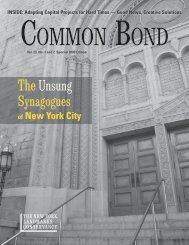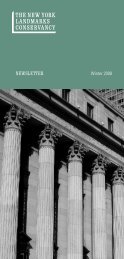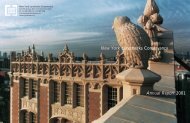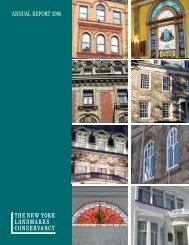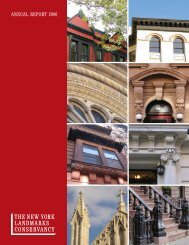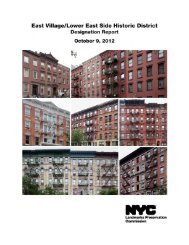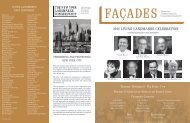Download Common Bond - The New York Landmarks Conservancy
Download Common Bond - The New York Landmarks Conservancy
Download Common Bond - The New York Landmarks Conservancy
Create successful ePaper yourself
Turn your PDF publications into a flip-book with our unique Google optimized e-Paper software.
usually the congregation or a local<br />
neighborhood organization–<br />
should contact the SHPO office.<br />
<strong>The</strong> SHPO’s office is split into<br />
geographic areas, with Field<br />
Representatives assigned to each<br />
area. <strong>The</strong> appropriate Field<br />
Representative will assist the<br />
congregation in the nomination<br />
process.<br />
<strong>The</strong> first step is the determination<br />
of eligibility. <strong>The</strong> sponsor submits<br />
two simple forms to prove that its<br />
property meets the National<br />
Register’s criteria for significance<br />
and is therefore eligible for listing.<br />
If the Field Representative finds<br />
that the property meets the<br />
criteria, the sponsor will be<br />
Nominations to both the<br />
State and the National<br />
Registers are made<br />
through one<br />
comprehensive<br />
application process<br />
directed (usually within one<br />
month) to proceed with the full<br />
nomination by completing the<br />
National Register of Historic<br />
Places Registration Form. This<br />
comprehensive document will<br />
further the argument for the<br />
building’s significance, and will<br />
detail its congregational and<br />
architectural history.<br />
<strong>The</strong> first eligibility form is a<br />
Building Structure Inventory<br />
Form–commonly referred to as a<br />
blue form, as per the color paper<br />
on which it is printed. <strong>The</strong> blue<br />
form serves as a preliminary<br />
inventory of structures within the<br />
historic property. <strong>The</strong> form asks<br />
for specific information about the<br />
building, such as its location,<br />
ownership, building materials,<br />
structural system, condition, and<br />
integrity. A photo of the premises<br />
and map must be included. <strong>The</strong><br />
form also has a section called<br />
“Historical and Architectural<br />
Importance” where reasons for the<br />
building’s eligibility are established.<br />
<strong>The</strong> property must be shown<br />
to meet at least one criterion from<br />
the list below. While the history of<br />
the property will be more thoroughly<br />
detailed in the Registration<br />
Form, the blue form is an opportunity<br />
to succinctly prove the<br />
building’s significance.<br />
National Register Criteria for<br />
Evaluation<br />
According to the National Parks<br />
Service, “<strong>The</strong> National Register’s<br />
standards for evaluating the<br />
significance of properties were<br />
developed to recognize the accomplishments<br />
of all peoples who have<br />
made a significant contribution to<br />
our country’s history and heritage.”<br />
Nominated properties must prove<br />
their significance based on general<br />
historic patterns, connections to<br />
important people or events,<br />
architectural value, or value to the<br />
study of history. <strong>The</strong> official<br />
criteria identifies districts, sites,<br />
buildings, structures, and objects as<br />
follows:<br />
A. That are associated with events<br />
that have made a significant<br />
contribution to the broad<br />
patterns of our history; or<br />
B. That are associated with the<br />
lives of persons significant in<br />
our past; or<br />
C. That embody the distinctive<br />
characteristics of a type,<br />
period, or method of construction<br />
that represent the work of a<br />
master, or that possess high<br />
artistic values, or that represent<br />
a significant and distinguishable<br />
entity whose components may<br />
lack individual distinction; or<br />
D. That have yielded or may be<br />
likely to yield, information<br />
important in prehistory or<br />
history.<br />
It is important to note that nominated<br />
religious properties must be<br />
<strong>Common</strong> <strong>Bond</strong> 14 Volume 16, No. 2/Winter 2001 ⏐ www.nylandmarks.org<br />
shown to have significance to the<br />
community, state, or country as a<br />
whole and not only to the members<br />
of a religious group. Most<br />
houses of worship qualify under<br />
criteria A and/or criteria C. In<br />
order to qualify under criteria A, a<br />
house of worship must contribute<br />
to the greater understanding or<br />
appreciation of historical events.<br />
For instance, the Foster Memorial<br />
A.M.E. Zion Church in Tarrytown<br />
was determined significant for<br />
playing an instrumental role<br />
during the Civil War by aiding<br />
escaping slaves. <strong>The</strong> nomination<br />
included information about how<br />
the church served as an important<br />
religious and cultural center for<br />
the African-American community.<br />
This significant historical role was<br />
found to contribute to the local<br />
community’s understanding of its<br />
history as well as to the broader<br />
history of the state and nation.<br />
To qualify for criteria C, houses of<br />
worship are frequently cited as<br />
outstanding examples of an<br />
architectural style or significant<br />
examples of an architect’s work.<br />
<strong>The</strong> Church of the Holy Cross in<br />
Troy, for example, is a Gothic<br />
Revival stone church that was<br />
designed by renowned architect<br />
Alexander Jackson Davis in 1843.<br />
<strong>The</strong> building was altered by<br />
Richard Upjohn, who is well<br />
known for his religious architecture.<br />
<strong>The</strong> church significantly<br />
contributes to the understanding<br />
of the work of both of these<br />
important American architects.<br />
<strong>The</strong> second form for determining<br />
eligibility is an application sheet.<br />
It provides the SHPO with the<br />
name of sponsor as well as contact<br />
information. <strong>The</strong> form also<br />
requires the applicant to explain<br />
why the nomination is being<br />
sought.<br />
Once the Field Representative has<br />
reviewed the blue forms and<br />
application form, s/he may request<br />
a site visit. This will be an<br />
opportunity for the representative



